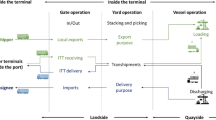Abstract
In this paper, we present and evaluate a neural network model for solving a typical personnel-scheduling problem, i.e. an airport ground staff rostering problem. Personnel scheduling problems are widely found in servicing and manufacturing industries. The inherent complexity of personnel scheduling problems has normally resulted in the development of integer programming-based models and various heuristic solution procedures. The neural network approach has been admitted as a promising alternative to solving a variety of combinatorial optimization problems. While few works relate neural network to applications of personnel scheduling problems, there is great theoretical and practical value in exploring the potential of this area. In this paper, we introduce a neural network model following a relatively new modeling approach to solve a real rostering case. We show how to convert a mixed integer programming formulation to a neural network model. We also provide the experiment results comparing the neural network method with three popular heuristics, i.e. simulated annealing, Tabu search and genetic algorithm. The computational study reveals some potential of neural networks in solving personnel scheduling problems.
Similar content being viewed by others
References
Arizono, I., A. Yamanoto, and H. Ohta. (1992). “Scheduling for Minimizing Total Actual Flow Time by Neural Networks.” Int. J. Prod. Res. 30(3), 503–511.
Bechtold, S.E. and L.W. Jacobs. (1990). “Implicit Modeling of Flexible Break Assignments in Optimal Shift Scheduling.” Mgmt. Sci. 36, 1339–1351.
Bechtold, S.E., M.J. Brusco, and M.J. Showalter. (1991). “A Comparative Evaluation of Labor Tour Scheduling Methods.” Dec. Sci. 22, 683–699.
Baker, K.R. (1976). “Workforce Allocation in Cyclical Scheduling Problems: A Survey.” Opns. Res. Quant. 27, 155–167.
Brusco, M.J., L.W. Jacobs, R.J. Bongiorno, D.V. Lyons, and B. Tang. (1995). “Improving Personnel Scheduling at Airline Stations.” Operations Research 43(5), 741–751.
Burke, L.I. (1994). “Neural Methods for the Traveling Salesman Problem: Insights for Operations Research.” Neural Networks 7(4), 681–690.
Burke, L.I. and J.P. Ignizio. (1992). “Neural Networks and Operations Research: An Overview.” Computers Ops. Res. 19(3-4), 179–189.
Censor, Y. and S.A. Zenios. (1997). Parallel Optimization: Theory, Algorithms and Applications. New York: Oxford University Press.
Chow, K.P. and C.K. Hui. (1987). “Knowledge-Based Approach to Scheduling Problems.” In Proceedings of the IEEE Asian Electronic Conference, September, pp. 404–409.
Chow, K.P. and C.K. Hui. (1993). “Knowledge-Based System for Rostering.” Expert Systems with Applications 6, 361–375.
Cichocki, A. and R. Unbehauen. (1993). Neural Networks for Optimization and Signal Processing. New York: Wiley.
Dagli, C.H., S. Lammers, and M. Vellanki. (1991). “Intelligent Scheduling in Manufacturing Using Neural Networks.” Journal of Neural Network Computing, Spring, 4–10.
Foo, Y.P. and Y. Takefuji. (1988a). “Stochastic Neural Networks for Solving Job-Shop Scheduling-Part 1: Problem Presentation.” In Proceedings of the Second IEEE International Conference on Neural Networks, July, pp. 275–282.
Foo,Y.P. and Y. Takefuji. (1988b). “Stochastic Neural Networks for Solving Job-Shop Scheduling-Part 2: Architecture and Simulation.” In Proceedings of the Second IEEE International Conference on Neural Networks, July, pp. 283–290.
Foo, Y.P. and Y. Takefuji. (1988c). “Integer Linear Programming Neural Networks for Job-Shop Scheduling.” In Proceedings of the Second IEEE International Conference on Neural Networks, July, pp. 341–348.
Fort, J.C. (1988). “Solving a Combinatorial Problem via Self-organizing Process: An Application of the Kohonen Algorithm to the Traveling Salesman Problem.” Biol. Cybern. 59, 33–40.
Henderson, W.B. and W.L. Berry. (1976). “Heuristic Methods for Telephone Operator Shift Scheduling: An Experimental Analysis.” Mgmt. Sci. 22, 1372–1380.
Hopfield, J.J. and D.W. Tank. (1985). “Neural Computation of Decisions in Optimization Problems.” Biol. Cybern. 5, 142–152.
Keith, E.G. (1979). “Operator Scheduling.” AIIE Trans. 11, 37–41.
Kova?i?, M. (1993). “Timetable Construction with Markovian Neural Network.” European Journal of Operational Research 69, 92–96.
Mausser, H.E., M.J. Magazine, and J.B. Moore. (1996). “Application of an Annealed Neural Network to a Timetabling Problem.” INFORMS Journal on Computing 8(2), 103–116.
Migdalas, A., P.M. Pardalos, and S. Story (eds.). (1997). Parallel Computation in Optimization. NewYork: Kluwer Academic.
Pellerin, D. and J. Herault. (1994). “Scheduling with Neural Networks: Application to Timetable Construction.” Eurocomputing 6, 419–442.
Peterson, C. (1990). “Parallel Distributed Approaches to Combinatorial Optimization: Benchmark Studies on Traveling Salesman Problem.” Neural Computation 2, 261–269.
Potvin, J. (1993). “The Traveling Salesman Problem: A Neural Network Perspective.” ORSA Journal on Computing 5(4).
Salleh, S. and A.Y. Zomaya. (1999). Scheduling in Parallel Computing Systems-Fuzzy and Annealing Techniques. Kluwer Academic.
Saratchandran, P., N. Dundararajan, and S.K. Foo. (1996). Parallel Implementation of Backpropagation Neural Networks on Transputers. World Scientific.
Schindler, S. and T. Semmel. (1993). “Station Staffing at Pan American World Airways.” Interfaces 23, 91–98.
Sharda, R. and J. Wang. (1996). “Neural Networks and Operations Research/Management Science.” European Journal of Operational Research (Feature Issue: Neural Networks and Operations Research/ Management Science) 93(2), 227–229.
Smith, K., M. Palaniswami, and M. Krishnamoorthy. (1996a). “Traditional Heuristic versus Hofield Neural Network Approaches to a Car Sequencing Problem.” European Journal of Operational Research 93, 300–316.
Smith, K., M. Palaniswami, and M. Krishnamoorthy. (1996b). “A Hybrid Neural Approach to Combinatorial Optimization.” Computers and Operations Research 23(6) 597–610.
Smith, K., M. Palaniswami, and M. Krishnamoorthy. (1998). “Neural Techniques for Combinatorial Optimization with Applications.” IEEE Transactions on Neural Networks 9(6), 1301–1318.
Takefuji, Y. and J. Wang (eds.). (1996). Neural Computing for Optimization and Combinatorics. World Scientific.
Watanabe, T., H. Tokumaru, and Y. Hashimoto. (1993). “Job-Shop Scheduling Using Neural Networks.” Control Eng. Practice 1(6), 957–961.
Willems and J.E. Rooda. (1994). “Neural Network for Job Shop Scheduling.” Control Eng. Practice 2(1), 31–39.
Zhou, D.N., V. Cherkassky, T.R. Baldwin, and D.E. Olson. (1991). “A Neural Network Approach to Job-Shop Scheduling.” IEEE Transactions on Neural Networks 2(1), 175–179.
Author information
Authors and Affiliations
Corresponding author
Rights and permissions
About this article
Cite this article
Hao, G., Lai, K. & Tan, M. A Neural Network Application in Personnel Scheduling. Annals of Operations Research 128, 65–90 (2004). https://doi.org/10.1023/B:ANOR.0000019099.29005.17
Issue Date:
DOI: https://doi.org/10.1023/B:ANOR.0000019099.29005.17




